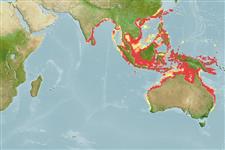>
Syngnathiformes (Pipefishes and seahorses) >
Syngnathidae (Pipefishes and seahorses) > Syngnathinae
Etymology: Hippocampus: Greek, ippos = horse + Greek,kampe = curvature (Ref. 45335); spinosissimus: Name from Latin word for winged, referring to the paired spines on the superior trunk ridges that are directed outward and have broad dermal flaps resembling wings (Ref. 42735).
More on author: Weber.
Environment: milieu / climate zone / depth range / distribution range
Ecologia
marino; salmastro associati a barriera corallina; non migratori; distribuzione batimetrica 10 - 80 m (Ref. 42735). Subtropical; 22°C - 27°C (Ref. 130605); 27°N - 36°S, 76°E - 155°E
Indo-Pacific: India and Sri Lanka to Australia; north to China.
Length at first maturity / Size / Peso / Age
Maturity: Lm 10.4 range ? - ? cm
Max length : 18.0 cm OT maschio/sesso non determinato; (Ref. 48635); 13.6 cm OT (female)
Short description
Chiavi di identificazione | Morfologia | Morfometria
Spine dorsali (totale) : 0; Raggi dorsali molli (totale) : 16 - 20.
Found in the continental shelf, on muddy, sandy bottoms, rubbles and in coral reefs (Ref. 75154); in a sponge or seagrass habitat, often attached to hard and soft coral species (Ref. 128284). Ovoviviparous (Ref. 205). The male carries the eggs in a brood pouch which is found under the tail (Ref. 205). Maximum length is based on a straight-line length measurement from upper surface (ignoring spines) of first trunk ring, to tip of tail; female 13.8 cm (Ref. 42735). Less desirable for traditional Chinese medicine, but use may increase with the rise in patent medicines. Taken in trawls (Ref. 42735).
Male carries the eggs in a brood pouch (Ref. 205).
Lourie, S.A., R.A. Pollom and S.J. Foster, 2016. A global revision of the seahorses Hippocampus Rafinesque 1810 (Actinopterygii: Syngnathiformes): taxonomy and biogeography with recommendations for further research. Zootaxa 4146(1):1-66. (Ref. 115213)
IUCN Red List Status (Ref. 130435)
Threat to humans
Harmless
Human uses
Pesca: commerciale; Acquario: Commerciale
Strumenti
Special reports
Download XML
Fonti Internet
Estimates based on models
Preferred temperature (Ref.
123201): 24.3 - 29.2, mean 28.3 °C (based on 992 cells).
Phylogenetic diversity index (Ref.
82804): PD
50 = 0.5000 [Uniqueness, from 0.5 = low to 2.0 = high].
Bayesian length-weight: a=0.00447 (0.00177 - 0.01127), b=3.00 (2.78 - 3.22), in cm total length, based on LWR estimates for this (Sub)family-body shape (Ref.
93245).
Trophic level (Ref.
69278): 3.4 ±0.5 se; based on size and trophs of closest relatives
Resilienza (Ref.
120179): Alto, tempo minimo di raddoppiamento della popolazione meno di 15 mesi (tm=0.5-1).
Fishing Vulnerability (Ref.
59153): Low vulnerability (10 of 100).
Nutrients (Ref.
124155): Calcium = 66.6 [31.9, 177.6] mg/100g; Iron = 0.848 [0.431, 1.529] mg/100g; Protein = 18.9 [17.6, 20.0] %; Omega3 = 0.209 [0.109, 0.393] g/100g; Selenium = 18.3 [7.4, 43.1] μg/100g; VitaminA = 39.7 [10.8, 147.1] μg/100g; Zinc = 1.27 [0.77, 1.98] mg/100g (wet weight);
